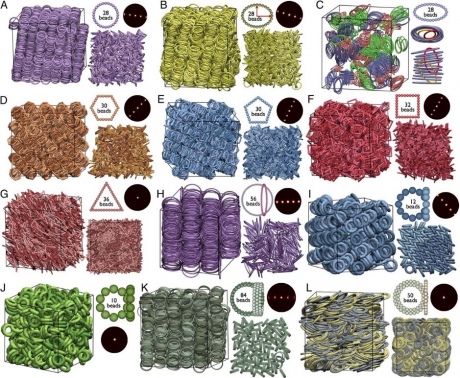Researchers develop new porous materials using doughnut nanorings

Image: Ella Marushchenko
Researchers propose a new design of highly open liquid-crystalline structures from geometrically unique rigid nanorings.
Researchers from Imperial College London, University of Manchester and Cornell University have used a computational approach to identify a new class of highly porous structures. The structures could be used to produce new materials which have potential applications for the pharmaceutical and photonics industries, among others.
When considering phases of matter, most people think of solid, liquid and gas states. A less-known phase with rather well-known applications is the intermediate between solids and liquids: the liquid crystal state. For instance, liquid crystal displays (LCD) are present in our everyday life, including calculators, phones, computers and TVs. The properties of this unique state of matter depend upon the degree of order in the material: in the smectic phase, molecules are orientationally ordered along one direction and they tend to arrange themselves in layers. Slightly closer to the liquid phase is the nematic phase, in which molecules have no positional order but are preferentially oriented along a given direction (the director).
In a new paper, entitled "Assembly of porous smectic structures formed from interlocking high-symmetry planar nanorings" which was published this week in the Proceedings of the National Academy of Sciences of the United States of America (PNAS), the authors used a molecular-simulation approach to examine several non-convex molecular geometrically different doughnut-shaped nanoring structures in order to identify the stable microstructures and their liquid-crystalline phase properties.
The researchers investigated a particular class of frame-like particles, namely perfectly rigid and planar nanorings, by direct molecular-dynamics simulation. Starting from a circular shape, they explored ellipsoidal and polygonal geometries; these were modelled by varying the symmetry, the cavity size and the width of the rings. Three types of nanoparticles were compared in terms of various properties: doughnuts (single rings formed from different numbers of tangent beads and symmetries); bands (multi-stacked circular rings made up of identical rings bound sideways); and washers (multi-layered circular rings made up of an outer ring and smaller inner rings).
The doughnut-like, high-symmetry nonconvex rings with large internal cavities were found to interlock within a two-dimensional layered structure leading to the formation of distinctive smectic phases which possess uniquely high free volumes of up to 95% - significantly larger than the 50% which is typically achievable with conventional convex rod- or disc-like particles whose geometries do not lead to this interlocking phenomenon therefore limiting their porosity.
These types of self-assembled arrays are particularly interesting due to their exceptional optical, electrical and mechanical properties which are a consequence of their large surface-to-volume ratios. The highly porous structures are good candidates as adsorption and storage materials and have promising opportunities in a broad range of applications including drug-delivery and therapeutics, catalysis, optics, photonics and nanopatterned scaffolds.
Professor Erich Muller, co-author of the paper and Professor of Thermodynamics in the Department of Chemical Engineering at Imperial College London said "For the first time, we have looked at geometrically unique nanoring structures and found that certain shapes and sizes can lead to highly porous structures with free volumes of up to 95%. This breakthrough has some exciting possible industrial applications in many areas due to their extraordinary electrical, optical and chemical properties."
The different models explored are shown in this figure from the paper. A basic circular ring structure is shown in the first model, from which the rest of the models are derived. The other six models are ellipsoidal rings with different aspect ratios and polygonal rings with decreasing order of rotational symmetry, all of which have similar cavity size as the first model. Models h) and i) show the two extremes of the number of beads which lead to the formation of smectic phases, while model j) is a structure which does not form an ordered fluid structure). The last two models represent a band and a washer model, respectively, where the former has smectic phase properties and the latter forms nematic phase. [Full size link]
Reference:
Funding:
Engineering and Physical Sciences Research Council (EPSRC)
US Department of Energy
National Science Foundation
Cover image credit: Ella Marushchenko
[Article co-written with Dora Olah an Undergraduate student in the Department of Chemical Engineering.]
Article text (excluding photos or graphics) © Imperial College London.
Photos and graphics subject to third party copyright used with permission or © Imperial College London.
Reporter
Michael Panagopulos
Department of Chemical Engineering
